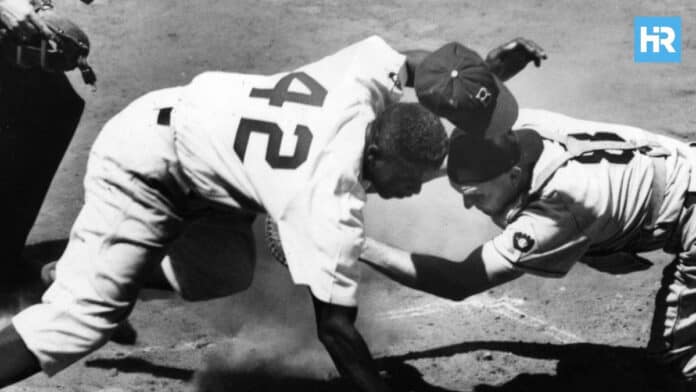On April 15, 1947, Jackie Robinson made history at Ebbets Field in Brooklyn, New York, by becoming the first African American player in Major League Baseball’s modern era. At age 28, he played for the Brooklyn Dodgers, breaking a color barrier that had divided professional baseball for more than 50 years.
Robinson’s debut ended the long-standing segregation that had kept Black athletes confined to the Negro Leagues since the late 19th century. His first appearance for the Dodgers symbolized the beginning of a new chapter in both sports and American social history.
Exactly fifty years later, on April 15, 1997, Major League Baseball Commissioner Bud Selig honored Robinson’s legacy at Shea Stadium in New York City. During a ceremony attended by over 50,000 fans, Selig announced that Robinson’s uniform number, 42, would be retired across all Major League Baseball teams – the first number in league history to receive that honor.
- On April 15, 1947, Jackie Robinson, age 28, became the first African American player in Major League Baseball’s modern era when he joined the Brooklyn Dodgers at Ebbets Field.
- Branch Rickey, the Dodgers’ general manager, began his plan to integrate baseball in 1942 and signed Robinson to a minor league contract on October 23, 1945, as part of his “great experiment.”
- Robinson’s achievements included being named Rookie of the Year (1947), National League MVP (1949), six-time All-Star (1949–1954), and helping the Dodgers win the 1955 World Series, leading to his 1962 induction into the Baseball Hall of Fame.
Early Life and Education: From Georgia to California
Jack Roosevelt Robinson was born on January 31, 1919, in Cairo, Georgia, to a family of sharecroppers. His mother moved the family to Pasadena, California, in 1920, where Robinson grew up and developed his athletic talent.
He attended John Muir Technical High School and Pasadena Community College before transferring to the University of California, Los Angeles (UCLA). At UCLA, he became the first athlete to letter in four varsity sports: baseball, football, basketball, and track.
Financial hardship forced Robinson to leave UCLA before completing his degree. In 1942, he entered the United States Army and was commissioned as a second lieutenant. While stationed in Texas, Robinson protested racial discrimination on a military bus. He was court-martialed in 1944 but acquitted, and later received an honorable discharge.
After his military service, Robinson played in the Negro American League for the Kansas City Monarchs during the 1945 season, appearing in 47 games and the East–West All-Star Game.
Branch Rickey’s Plan to Integrate Baseball
By the 1940s, organized baseball had been racially segregated for many years. The Black press and some white sportswriters actively campaigned for integration. Among them, Wendell Smith of The Pittsburgh Courier was particularly outspoken. The experience of World War II further encouraged Americans to question segregation.
Branch Rickey (1881–1965), the Brooklyn Dodgers’ general manager, took direct action to challenge the “color line.” Rickey had been active in baseball for over 60 years, working as a player, coach, manager, and owner. His Hall of Fame plaque credits him with both creating the farm system in the 1920s and signing Jackie Robinson.
Rickey’s interest in integration began earlier in his career. While working with the St. Louis Cardinals, he was disturbed by the exclusion of African Americans from grandstand seating. In 1942, after joining the Dodgers, Rickey quietly began planning to bring Black players into Major League Baseball.
He referred to this effort as his “great experiment.” Rickey understood that the first Black player in the majors would be subjected to extreme scrutiny and hostility. He therefore sought an individual with athletic ability and exceptional self-control.
The Meeting Between Branch Rickey and Jackie Robinson
In August 1945, Jackie Robinson, then a member of the Kansas City Monarchs, met Branch Rickey at the Brooklyn Dodgers’ office. Clyde Sukeforth, a Dodgers scout, told Robinson that Rickey was assembling a new team called the Brown Dodgers, but during the meeting, Rickey revealed his true intention: to bring Robinson to the Major Leagues.
Rickey simulated scenes Robinson might face, including verbal abuse and provocation, to test his reactions, though Robinson remained calm. Rickey then told him directly that he was looking for a player with the strength “not to fight back.”
Following the meeting, on October 23, 1945, Robinson officially signed a contract with the Dodgers’ Triple-A affiliate, the Montreal Royals. The signing was publicized nationally through Look magazine and in the Black press by Wendell Smith of The Pittsburgh Courier.
Before finalizing the agreement, Rickey verified that Robinson was not bound by a formal contract with the Monarchs. Robinson confirmed this in writing in a letter preserved in the Branch Rickey Papers.
Robinson spent the 1946 season with the Montreal Royals, where his success on the field prepared him for the next step.
The 1947 Major League Debut
After his season in Montreal, Jackie Robinson joined the Brooklyn Dodgers in April 1947, officially breaking the Major League color barrier. Wearing number 42, Robinson became a star infielder and outfielder for the Dodgers.
During his rookie season, Robinson helped lead the Dodgers to the National League pennant and was named the National League’s Rookie of the Year. In 1949, he was voted the Most Valuable Player (MVP) and became the league batting champion.
Between 1949 and 1954, Robinson was selected for the National League All-Star team each year. Over the course of his career, he helped the Dodgers win six National League pennants and their first World Series championship in 1955.
Racism and Resistance During Robinson’s Career
Robinson faced widespread racial discrimination throughout his playing years. Many fans and even fellow players expressed hostility toward him. Jim Crow laws in the South prevented him from using the same hotels and restaurants as his white teammates. Despite these obstacles, he continued to perform at the highest level.
His success paved the way for other African American players to enter Major League Baseball. The Brooklyn Dodgers later signed Roy Campanella (1948), Don Newcombe (1949), and Jim Gilliam (1953). In the American League, Larry Doby integrated the Cleveland Indians in 1947, followed by future stars such as Hank Aaron and Willie Mays.
Life After Baseball
Jackie Robinson retired from Major League Baseball in 1957. After his playing career, he became a businessman and civil rights activist. He supported the work of Dr. Martin Luther King Jr. and participated in civil rights demonstrations.
In 1960, Robinson joined a picket line in Cleveland, Ohio, organized by the NAACP, to protest racial discrimination at southern lunch counters.
In 1962, Robinson became the first African American inducted into the National Baseball Hall of Fame in his first year of eligibility.
He died on October 24, 1972, at age 53, in Stamford, Connecticut.
Legacy and Ongoing Recognition
Although the Brooklyn Dodgers relocated to Los Angeles after the 1957 season, Robinson’s legacy remained deeply connected to Brooklyn. Ebbets Field, where he made his debut, was eventually demolished, but its historical significance endured.
Citi Field, home of the New York Mets, features the Jackie Robinson Rotunda, honoring his contribution to the sport. A statue of Jackie Robinson and Pee Wee Reese stands outside the Coney Island stadium of the Brooklyn Cyclones, symbolizing unity and respect.
Every year, on April 15, Major League Baseball observes Jackie Robinson Day, during which all players wear his number, 42, to commemorate his achievements.






